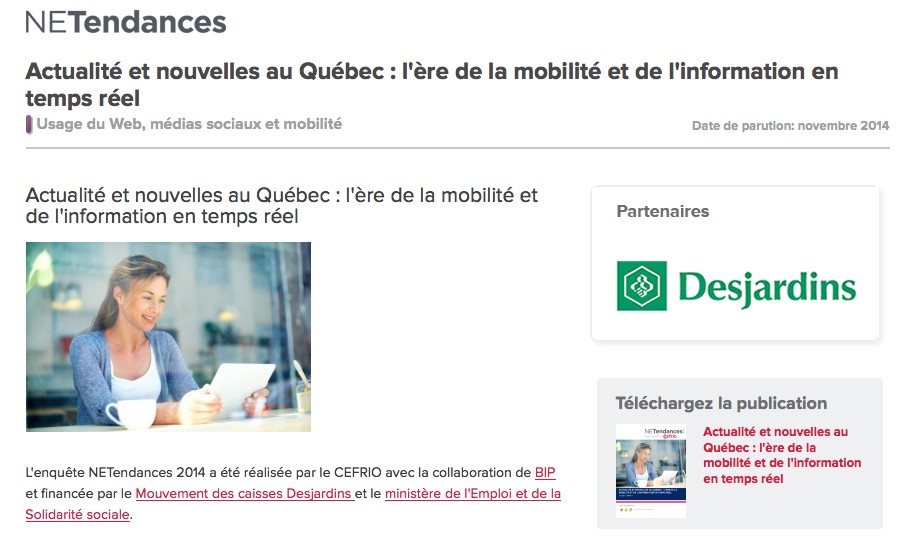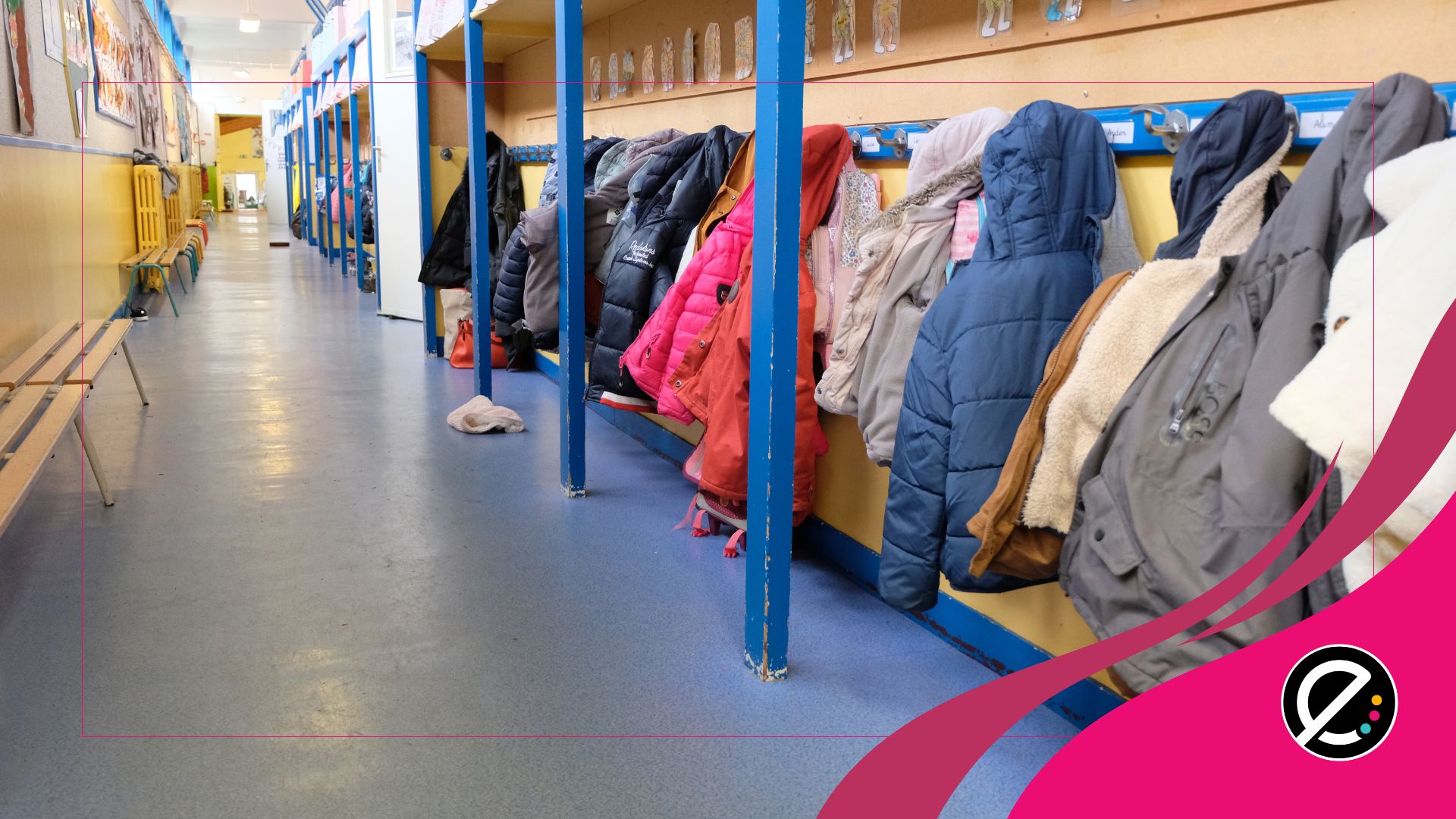Québec, le 27 novembre 2014 – Consulter les actualités et les nouvelles à partir d’un appareil mobile (téléphone intelligent, tablettes ou liseuses numériques, etc.) est une tendance en forte hausse au Québec en 2014. Les données du volet « actualités et nouvelles » de l’enquête NETendances révèlent que près de 40 % des adultes québécois (38,2 %) s’informent désormais sur un appareil mobile, une proportion en nette hausse par rapport à 2012 où moins d’un adulte sur cinq (17,4%) s’informait à partir d’un tel appareil.
Cette croissance de la consultation d’actualités et de nouvelles à partir d’un appareil mobile est attribuable en grande partie à la proportion plus importante d’adultes québécois qui détiennent des téléphones intelligents et des tablettes. En 2012, 12,7 % des adultes québécois disposaient d’une tablette numérique et 31,5 % d’un téléphone intelligent, ces proportions ont bondis à 38,9 % et 52,3 % respectivement en 2014.
« L’explosion des options disponibles pour consulter les nouvelles et l’actualité sur Internet complexifie la tâche des médias traditionnels. L’information abonde sur le Web et elle est le plus souvent disponible gratuitement et en tout temps, ce qui nuit considérablement aux revenus des médias traditionnels, qui doivent se réinventer » affirme Claire Bourget, directrice principale, recherche marketing au CEFRIO. « Mais l’engouement croissant pour l’information sur appareils mobiles ouvre de nouvelles portes aux diffuseurs de nouvelles. Les quotidiens sont d’ailleurs de plus en plus nombreux à s’être dotés de versions pour tablettes, à l’instar de La Presse : Le Devoir, The Gazette, le Toronto Star prochainement, et d’autres », conclut Claire Bourget.
La proportion d’adultes qui consultent l’actualité à partir d’un appareil mobile est plus élevée chez ceux qui disposent d’un revenu familial élevé, tout comme elle l’est chez les adultes possédant un diplôme de niveaux collégial ou universitaire.
Consultez les résultats complets et graphiques en ligne >
Internet en voie de s’imposer comme principale source d’information
Si la télévision demeure encore la principale source pour s’informer chez l’ensemble des adultes québécois (46,4 %), Internet gagne du terrain en 2014, passant de la source principale d’information d’un adulte québécois sur cinq (19,7 %) en 2013 à celle d’un sur quatre (26,4 %). Et pour certains sous-groupes d’âge, tel que chez les étudiants, Internet devance largement la télévision comme principale source d’information (64,5 % et 17,3 % respectivement).
La presse écrite quant à elle tend à être de moins en moins populaire comme principale source d’information, perdant 4,9 points de pourcentage entre 2012 (22,5 %) et 2014 (17,6 %). De son côté, à 7,7 %, la popularité de la radio demeure stable.
« L’enquête NETendances confirme l’érosion lente des médias imprimés au profit d’Internet comme source primaire d’information continue, sans doute amplifiée par le lancement de La Presse + en 2013. La bonne tenue de la télévision, que près de la moitié des adultes continue d’utiliser comme média principal, montre qu’il y a encore de la place pour les médias traditionnels – en particulier les réseaux d’information continue – dans la mesure où on peut y accéder par le Web », commente Bernard Motulsky, titulaire de la Chaire de relations publiques et communication marketing de l’UQAM et chercheur associé au CEFRIO.
Les adultes québécois adeptes d’information en temps réel
Trois adultes québécois sur cinq (59,1 %) suivent activement l’évolution d’évènements ou de situations sur le Web. La météo est le type d’information suivi en temps réel par la plus importante proportion d’adultes québécois (49,5 %). Les nouvelles de l’actualité (31,8 %), les évènements culturels (29,8 %), les résultats sportifs (24,6 %) et les résultats d’élection (24,5 %) sont, de leur côté, suivis activement en ligne par au moins un adulte québécois sur quatre.
Twitter loin derrière les principales sources consultées sur Internet
Les sites Internet de nouvelles et d’actualités constituent la principale source d’information d’un adulte québécois sur dix (11,7 % les citent comme première mention). Ils sont suivis des réseaux sociaux (excluant Twitter) à 4,9 %, des applications pour appareils mobiles à 4,5 %, des moteurs de recherche dédiés aux actualités (2,2 %) et des portails d’information (1,7 %). À moins d’un pourcent (0,2 %), les microblogues tels que Twitter ne sont la principale source d’information que d’une infime proportion d’adultes québécois.
Les résultats détaillés incluant tableaux, graphiques, données sociodémographiques et méthodologie sont disponibles en ligne : http://cefr.io/vol5no5.
À propos de NETendances
L’enquête NETendances du CEFRIO dresse un portrait intégré et actualisé des grandes tendances en matière d’utilisation d’Internet et des TIC sur l’ensemble du territoire québécois. NETendances 2014 a été réalisée grâce au soutien financier du Mouvement des caisses Desjardins et du ministère de l’Emploi et de la Solidarité sociale, sans oublier la collaboration de BIP – Bureau d’interviewers professionnels pour la collecte de données.
À propos du CEFRIO
Depuis plus de 25 ans, le CEFRIO accompagne les organisations publiques et privées dans la transformation de leurs processus et pratiques d’affaires par l’appropriation et l’utilisation du numérique. Centre de liaison et transfert reconnu, le CEFRIO est mandaté par le gouvernement du Québec afin de contribuer à l’avancement de la société québécoise par le numérique. Il recherche, expérimente, enquête et fait connaître les usages du numérique dans tous les volets de la société. Son action s’appuie sur une équipe expérimentée, un réseau de quelque 80 chercheurs associés et invités ainsi que l’engagement de plus de 150 membres.
Source : CEFRIO






